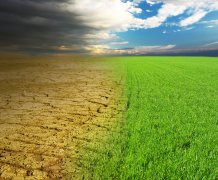Articles

Image courtesy of shutterstock
Study seeks to understand variations in the rate of global warming
A new study has looked at slow-downs in the rate of global surface warming, despite ongoing increases in the emissions of greenhouse gases.
A team of climate scientists, including Professor Mat Collins from the University of Exeter, have investigated the role of internal variability in the Earth’s climate system in these periods of slow warming.
This internal variability refers to natural variations in regional climate, such as El Nino and the Pacific Decadal Oscillation, that arise in the absence of changes in forcing from volcanic aerosols, solar activity or human influences.
Scientific opinion is still divided on the precise cause of the current slowdown, although there is evidence that natural internal variability has played a significant role, probably alongside some changes in external forcing. There is also evidence that slow-down events similar to the current one have occurred many times before.
Professor Collins, co-author of the report from Exeter’s Mathematics department said: “The fact that the world is warming as a result of human emissions of greenhouse gases is not in doubt, but this paper shows how short-term trends can be quite variable as a result of intrinsic fluctuations in climate.
“More research is urgently needed to understand these fluctuations and learn how predictable they might be.”
The new study looks at this issue by using a huge archive of climate model simulations collected from a number of international research centres. These are used to study whether internal variability has the potential to offset the expected global surface warming rate of 0.2K/decade (0.2° C/decade) associated with human influences.
This archive of 15,000 years of simulated climate represents a ‘laboratory’ in which to study the characteristics of the internal climate variability in the absence of changes in external forcing. This would be impossible to disentangle from the relatively short 150 years of the global observational record where a number of external forcings come into play.
The researchers found that 20-year periods of global cooling in excess of 0.2K/decade can occur as a result of internal variability alone about once every hundred years. Once cooling has been established for 15 years there is a high chance (up to 1 in 4) that this will persist for a further 5 years.
This study also shows that periods of extended global cooling from internal variability alone are associated with more heat being taken up by the sub-surface ocean; when this ends, this heat can be released quite rapidly leading to a period of accelerated global warming.
The implications of these results for the current slow-down in global surface warming are important. They show that the recent slow-down lies within the range of possible internal variations, and so internal variability cannot be excluded as a possible explanation. Furthermore they suggest that persistence of the current slow-down beyond 15 years may be quite likely.
Finally it is entirely possible that once the current slow-down finishes, it may be followed by a period of accelerated global surface warming. Understanding this better is one aspect of managing the risks and opportunities associated with future climate variability and change.
The study was motivated by the fact that global average temperature has not risen as fast as expected in the 15 years since the start of the 21st Century.
This current slowdown in global warming has also be referred to as the “pause” or the “hiatus” in climate science literature, and in the media.
The slowdown has been used by some to call into question the reliability of climate models - but climate scientists know that natural climate variations mean we shouldn’t expect global average temperature to rise smoothly in response to the accumulation of greenhouse gases in the atmosphere. Indeed, the Earth’s surface has shown faster and slower periods of warming, even in the last century.
The study uses long “control” simulations of the Earth as it would be if unaffected by human influence, to find out how long these natural oscillations might contribute to a warming slowdown.
The authors studied the statistics of temperature trends that could temporarily enhance - or offset - global warming, on a timescale of one or two decades.
Previous studies have emphasised the role of decadal variability of ocean surface temperatures and the Trade winds in the Pacific Ocean in the warming slowdown, although enhanced volcanic activity, and lower solar activity, are thought to contribute.
The study is led by Met Office climate scientist, Chris Roberts, and colleagues. They point out that this isn’t a forecast for a continued warming pause, however.
“We looked at the statistics of hypothetical pauses driven solely by natural variability. It’s possible that the current slowdown has other causes as well”, said co-author Doug McNeall from the Met Office. “It’s important to remember that those other causes - like aerosols from volcanic eruptions or industry - could lengthen a pause in global warming, so we shouldn’t be too surprised if the pause continues.”
Date: 23 February 2015
